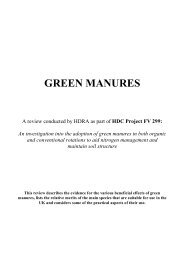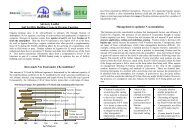A review of leguminous fertility-building crops, with particular ...
A review of leguminous fertility-building crops, with particular ...
A review of leguminous fertility-building crops, with particular ...
Create successful ePaper yourself
Turn your PDF publications into a flip-book with our unique Google optimized e-Paper software.
A <strong>review</strong> <strong>of</strong> <strong>leguminous</strong> <strong>fertility</strong>-<strong>building</strong> <strong>crops</strong>, Defra project OF0316 2. Rotational aspects<br />
Table 2.7. The relative importance <strong>of</strong> invertebrate pests in <strong>fertility</strong>-<strong>building</strong> and catch<br />
<strong>crops</strong>. (*** Major pest frequently capable <strong>of</strong> causing yield loss; ** Often present but only<br />
occasionally affects yield; * Sporadic, only rarely affects yield)<br />
Crop Pest Importance Comments<br />
Peas and beans<br />
(continued)<br />
Trefoils, vetches and<br />
other legumes<br />
Bryobia mites * Rarely <strong>of</strong> commercial<br />
importance<br />
Pea cyst nematode ** Localised, <strong>particular</strong>ly east <strong>of</strong><br />
England<br />
Stem nematode ** Both oat-onion and giant bean<br />
race important<br />
Pea moth * Has been bred on meadow<br />
vetchling and tufted vetch<br />
Bryobia mites * Will feed on a range <strong>of</strong> legumes<br />
Pea cyst nematodes * Will multiply on wild vetches<br />
Stem nematodes * Risk dependent on race present<br />
Stubble turnips Flea beetles *** Potential damage in dry springs<br />
(Phyllotreta spp.)<br />
and summer<br />
Cabbage stem flea<br />
beetle<br />
**<br />
Turnip gall weevil * Negligible affect on yield<br />
Cabbage root fly ** Primarily risk from third<br />
generation flies<br />
Beet cyst nematode *<br />
Peach potato aphid * Potential virus transmission<br />
Mustard Turnip gall weevil *<br />
Beet cyst nematode *<br />
Mustard beetle * Sporadic pest, invades <strong>crops</strong> in<br />
spring<br />
2.3.4. The potential for pest attack in <strong>crops</strong> following <strong>fertility</strong>-<strong>building</strong> <strong>crops</strong><br />
The risk <strong>of</strong> carry over <strong>of</strong> pests from a <strong>fertility</strong>-<strong>building</strong> crop to subsequent cereal or other<br />
arable and horticultural <strong>crops</strong> is summarised in Tables 2.8 and 2.9, respectively. Further<br />
detail on specific interactions between the <strong>fertility</strong>-<strong>building</strong> crop and subsequent crop are<br />
provided in the following paragraphs.<br />
Carry over <strong>of</strong> pests from clover<br />
Slugs, leather jackets and wireworms and are the major pests which could pose a threat to<br />
any subsequent crop following a clover ley. Slug damage is reduced in well-consolidated<br />
seedbeds <strong>with</strong> a fine tilth, where there are fewer air spaces in the soil structure in which the<br />
slugs can move and feed. Consequently, avoidance <strong>of</strong> slug damage <strong>of</strong>ten depends on what<br />
success the farmer has in preparing a fine and firm seedbed.<br />
Cereal <strong>crops</strong> sown in the early autumn are generally less vulnerable to slug attack than later<br />
sowings. Early sowing results in rapid germination, less exposure to the risk <strong>of</strong> grain<br />
hollowing and the establishment <strong>of</strong> plants that are better able to outgrow slug damage than<br />
smaller and slower growing plants <strong>of</strong> later sowings (Port & Port, 1986). However, early<br />
Written by S Cuttle, M Shepherd & G Goodlass Page 38




